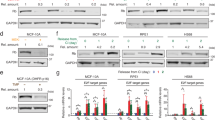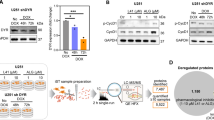Abstract
Inactivation of the retinoblastoma (RB) tumor suppressor pathway, via elevated cyclin-dependent kinase (CDK) activity, is observed in majority of human cancers. Since CDK deregulation is evident in most cancer cells, pharmacological CDK inhibition has become an attractive therapeutic strategy in oncology. We recently showed that an oncogenic CDK4R24C mutation alters the subcellular localization of the normally nuclear RB phosphoprotein. Here, using 71 human cancer cell lines and over 300 primary human cancer tissues, we investigated whether changes in RB subcellular localization occur during human cancer progression. We uncover that diverse human cancers and their derived cell lines, particularly those with poor tumor differentiation, display significant cytoplasmic mislocalization of ordinarily nuclear RB. The nucleocytoplasmically distributed RB was derived via CDK-dependent and Exportin1-mediated nuclear export. Indeed, cytoplasmically mislocalized RB could be efficiently confined to the nucleus by pharmacologically reducing CDK activity or by inhibiting the Exportin1-mediated nuclear export pathway. Our observations uncover a post-translational CDK-dependent mechanism of RB inactivation and suggest that cytoplasmically localized RB may harbor a tumor promoting function. We propose that RB inactivation, via aberrant nucleocytoplasmic transport, may disrupt normal cell differentiation programs and accelerate the cancer process. These results are evidence that tumor cells modulate the protein transport machinery thereby making the protein transport process a viable therapeutic target.
This is a preview of subscription content, access via your institution
Access options
Subscribe to this journal
Receive 50 print issues and online access
$259.00 per year
only $5.18 per issue
Buy this article
- Purchase on Springer Link
- Instant access to full article PDF
Prices may be subject to local taxes which are calculated during checkout



Similar content being viewed by others
References
Alkarain A, Jordan R, Slingerland J . (2004). p27 deregulation in breast cancer: prognostic significance and implications for therapy. J Mammary Gland Biol Neoplasia 9: 67–80.
Blain SW, Massague J . (2002). Breast cancer banishes p27 from nucleus. Nat Med 8: 1076–1078.
Boyd SD, Tsai KY, Jacks T . (2000). An intact HDM2 RING-finger domain is required for nuclear exclusion of p53. Nat Cell Biol 2: 563–568.
Braunschweig T, Chung JY, Hewitt SM . (2005). Tissue microarrays: bridging the gap between research and the clinic. Expert Rev Proteomics 2: 325–336.
Camphausen K, Brady KJ, Burgan WE, Cerra MA, Russell JS, Bull EE et al. (2004). Flavopiridol enhances human tumor cell radiosensitivity and prolongs expression of gammaH2AX foci. Mol Cancer Ther 3: 409–416.
Chestukhin A, Litovchick L, Rudich K, DeCaprio JA . (2002). Nucleocytoplasmic shuttling of p130/RBL2: novel regulatory mechanism. Mol Cell Biol 22: 453–468.
Classon M, Harlow E . (2002). The retinoblastoma tumour suppressor in development and cancer. Nat Rev Cancer 2: 910–917.
Durfee T, Mancini MA, Jones D, Elledge SJ, Lee WH . (1994). The amino-terminal region of the retinoblastoma gene product binds a novel nuclear matrix protein that co-localizes to centers for RNA processing. J Cell Biol 127: 609–622.
Geyer RK, Yu ZK, Maki CG . (2000). The MDM2 RING-finger domain is required to promote p53 nuclear export. Nat Cell Biol 2: 569–573.
Goodrich DW . (2006). The retinoblastoma tumor-suppressor gene, the exception that proves the rule. Oncogene 25: 5233–5243.
Haluska FG, Hodi FS . (1998). Molecular genetics of familial cutaneous melanoma. J Clin Oncol 16: 670–682.
Hanahan D, Weinberg RA . (2000). The hallmarks of cancer. Cell 100: 57–70.
Henderson BR . (2000). Nuclear-cytoplasmic shuttling of APC regulates beta-catenin subcellular localization and turnover. Nat Cell Biol 2: 653–660.
Inman GJ, Nicolas FJ, Hill CS . (2002). Nucleocytoplasmic shuttling of Smads 2, 3, and 4 permits sensing of TGF-beta receptor activity. Mol Cell 10: 283–294.
Jiao W, Datta J, Lin HM, Dundr M, Rane SG . (2006). Nucleocytoplasmic shuttling of the retinoblastoma tumor suppressor protein via Cdk phosphorylation-dependent nuclear export. J Biol Chem 281: 38098–38108.
Kaighn ME, Narayan KS, Ohnuki Y, Lechner JF, Jones LW . (1979). Establishment and characterization of a human prostatic carcinoma cell line (PC-3). Invest Urol 17: 16–23.
Kastan MB, Zambetti GP . (2003). Parc-ing p53 in the cytoplasm. Cell 112: 1–2.
Kau TR, Way JC, Silver PA . (2004). Nuclear transport and cancer: from mechanism to intervention. Nat Rev Cancer 4: 106–117.
Khidr L, Chen PL . (2006). RB, the conductor that orchestrates life, death and differentiation. Oncogene 25: 5210–5219.
Knudsen ES, Wang JY . (1997). Dual mechanisms for the inhibition of E2F binding to RB by cyclin-dependent kinase-mediated RB phosphorylation. Mol Cell Biol 17: 5771–5783.
Liang J, Zubovitz J, Petrocelli T, Kotchetkov R, Connor MK, Han K et al. (2002). PKB/Akt phosphorylates p27, impairs nuclear import of p27 and opposes p27-mediated G1 arrest. Nat Med 8: 1153–1160.
Liggett Jr WH, Sidransky D . (1998). Role of the p16 tumor suppressor gene in cancer. J Clin Oncol 16: 1197–1206.
Lu S, Tsai SY, Tsai MJ . (1997). Regulation of androgen-dependent prostatic cancer cell growth: androgen regulation of CDK2, CDK4, and CKI p16 genes. Cancer Res 57: 4511–4516.
Malumbres M, Barbacid M . (2001). To cycle or not to cycle: a critical decision in cancer. Nat Rev Cancer 1: 222–231.
Mittnacht S, Lees JA, Desai D, Harlow E, Morgan DO, Weinberg RA . (1994). Distinct sub-populations of the retinoblastoma protein show a distinct pattern of phosphorylation. EMBO J 13: 118–127.
Mittnacht S, Weinberg RA . (1991). G1/S phosphorylation of the retinoblastoma protein is associated with an altered affinity for the nuclear compartment. Cell 65: 381–393.
Muller H, Bracken AP, Vernell R, Moroni MC, Christians F, Grassilli E et al. (2001). E2Fs regulate the expression of genes involved in differentiation, development, proliferation, and apoptosis. Genes Dev 15: 267–285.
Nork TM, Millecchia LL, Poulsen G . (1994). Immunolocalization of the retinoblastoma protein in the human eye and in retinoblastoma. Invest Ophthalmol Vis Sci 35: 2682–2692.
Ortega S, Malumbres M, Barbacid M . (2002). Cyclin D-dependent kinases, INK4 inhibitors and cancer. Biochim Biophys Acta 1602: 73–87.
Paull KD, Shoemaker RH, Hodes L, Monks A, Scudiero DA, Rubinstein L et al. (1989). Display and analysis of patterns of differential activity of drugs against human tumor cell lines: development of mean graph and COMPARE algorithm. J Natl Cancer Inst 81: 1088–1092.
Rane SG, Cosenza SC, Mettus RV, Reddy EP . (2002). Germ line transmission of the Cdk4(R24C) mutation facilitates tumorigenesis and escape from cellular senescence. Mol Cell Biol 22: 644–656.
Rane SG, Dubus P, Mettus RV, Galbreath EJ, Boden G, Reddy EP et al. (1999). Loss of Cdk4 expression causes insulin-deficient diabetes and Cdk4 activation results in beta-islet cell hyperplasia. Nat Genet 22: 44–52.
Rosin-Arbesfeld R, Townsley F, Bienz M . (2000). The APC tumour suppressor has a nuclear export function. Nature 406: 1009–1012.
Schwartz GK, Shah MA . (2005). Targeting the cell cycle: a new approach to cancer therapy. J Clin Oncol 23: 9408–9421.
Sedlacek HH . (2001). Mechanisms of action of flavopiridol. Crit Rev Oncol Hematol 38: 139–170.
Shapiro GI . (2006). Cyclin-dependent kinase pathways as targets for cancer treatment. J Clin Oncol 24: 1770–1783.
Shin I, Yakes FM, Rojo F, Shin NY, Bakin AV, Baselga J et al. (2002). PKB/Akt mediates cell-cycle progression by phosphorylation of p27(Kip1) at threonine 157 and modulation of its cellular localization. Nat Med 8: 1145–1152.
Sotillo R, Dubus P, Martin J, de la Cueva E, Ortega S, Malumbres M et al. (2001a). Wide spectrum of tumors in knock-in mice carrying a Cdk4 protein insensitive to INK4 inhibitors. EMBO J 20: 6637–6647.
Sotillo R, Garcia JF, Ortega S, Martin J, Dubus P, Barbacid M et al. (2001b). Invasive melanoma in Cdk4-targeted mice. Proc Natl Acad Sci USA 98: 13312–13317.
Stade K, Ford CS, Guthrie C, Weis K . (1997). Exportin 1 (Crm1p) is an essential nuclear export factor. Cell 90: 1041–1050.
Stevens C, La Thangue NB . (2003). E2F and cell cycle control: a double-edged sword. Arch Biochem Biophys 412: 157–169.
Stokke T, Erikstein BK, Smedshammer L, Boye E, Steen HB . (1993). The retinoblastoma gene product is bound in the nucleus in early G1 phase. Exp Cell Res 204: 147–155.
Sui G, Soohoo C, Affar el B, Gay F, Shi Y, Forrester WC . (2002). A DNA vector-based RNAi technology to suppress gene expression in mammalian cells. Proc Natl Acad Sci USA 99: 5515–5520.
Viglietto G, Motti ML, Bruni P, Melillo RM, D'Alessio A, Califano D et al. (2002). Cytoplasmic relocalization and inhibition of the cyclin-dependent kinase inhibitor p27(Kip1) by PKB/Akt-mediated phosphorylation in breast cancer. Nat Med 8: 1136–1144.
Weinstein JN, Kohn KW, Grever MR, Viswanadhan VN, Rubinstein LV, Monks AP et al. (1992). Neural computing in cancer drug development: predicting mechanism of action. Science 258: 447–451.
Weis K . (2003). Regulating access to the genome: nucleocytoplasmic transport throughout the cell cycle. Cell 112: 441–451.
Wolfel T, Hauer M, Schneider J, Serrano M, Wolfel C, Klehmann-Hieb E et al. (1995). A p16INK4a-insensitive CDK4 mutant targeted by cytolytic T lymphocytes in a human melanoma. Science 269: 1281–1284.
Xu L, Massague J . (2004). Nucleocytoplasmic shuttling of signal transducers. Nat Rev Mol Cell Biol 5: 209–219.
Yen A, Coder D, Varvayanis S . (1997). Concentration of RB protein in nucleus vs cytoplasm is stable as phosphorylation of RB changes during the cell cycle and differentiation. Eur J Cell Biol 72: 159–165.
Zacksenhaus E, Bremner R, Phillips RA, Gallie BL . (1993). A bipartite nuclear localization signal in the retinoblastoma gene product and its importance for biological activity. Mol Cell Biol 13: 4588–4599.
Ziegler EC, Ghosh S . (2005). Regulating inducible transcription through controlled localization. Sci STKE 2005: re6.
Zuo L, Weger J, Yang Q, Goldstein AM, Tucker MA, Walker GJ et al. (1996). Germline mutations in the p16INK4a binding domain of CDK4 in familial melanoma. Nat Genet 12: 97–99.
Acknowledgements
We thank Yang Shi (siCDK2), Krishnendu Roy (Flavopiridol), Susan Holbeck (NCI-60 cell lines); Tatiana Karpova (LRBGE imaging facility) for microscopy training. Jashodeep Datta was supported by the Colgate University-NIH internship. This research was supported by the Intramural Research Program of the NIH.
Author information
Authors and Affiliations
Corresponding author
Additional information
Supplementary Information accompanies the paper on the Oncogene website (http://www.nature.com/onc).
Supplementary information
Rights and permissions
About this article
Cite this article
Jiao, W., Lin, HM., Datta, J. et al. Aberrant nucleocytoplasmic localization of the retinoblastoma tumor suppressor protein in human cancer correlates with moderate/poor tumor differentiation. Oncogene 27, 3156–3164 (2008). https://doi.org/10.1038/sj.onc.1210970
Received:
Revised:
Accepted:
Published:
Issue Date:
DOI: https://doi.org/10.1038/sj.onc.1210970
Keywords
This article is cited by
-
Inhibiting cancer cell hallmark features through nuclear export inhibition
Signal Transduction and Targeted Therapy (2016)
-
RanBP3 Regulates Melanoma Cell Proliferation via Selective Control of Nuclear Export
Journal of Investigative Dermatology (2016)
-
Identification and characterization of nuclear and nucleolar localization signals in 58-kDa microspherule protein (MSP58)
Journal of Biomedical Science (2015)
-
Inhibition of CRM1-Mediated Nucleocytoplasmic Transport: Triggering Human Melanoma Cell Apoptosis by Perturbing Multiple Cellular Pathways
Journal of Investigative Dermatology (2012)
-
Inactivation of Rb in stromal fibroblasts promotes epithelial cell invasion
The EMBO Journal (2012)



